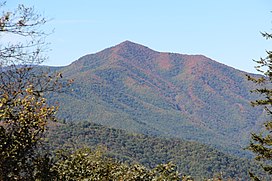
Back جبل كولد ARZ Cold Mountain (bukid sa Tinipong Bansa, North Carolina, Haywood County) CEB کولڈ ماؤنٹین (شمالی کیرولائنا) Urdu
| Cold Mountain | |
|---|---|
 Cold Mountain as seen from the Blue Ridge Parkway | |
| Highest point | |
| Elevation | 6,030 ft (1,840 m) |
| Prominence | 990 ft (300 m) |
| Coordinates | 35°24′34″N 82°51′22″W / 35.40944°N 82.85611°W |
| Geography | |
| Location | Haywood County, North Carolina, U.S. |
| Parent range | Great Balsam Mountains |
| Topo map | USGS Cruso |
| Climbing | |
| Easiest route | Hike |
Cold Mountain falls in the mountain region of western North Carolina, United States.[1] The mountain is one of the Great Balsam Mountains which are a part of the Blue Ridge Mountains within the Appalachian Mountains. Cold Mountain and the Shining Rock Wilderness surrounding it are part of Pisgah National Forest.
Cold Mountain is about 15 miles (24 kilometers) southeast of Waynesville and 35 miles (56 kilometers) south of Asheville. It rises to 6,030 feet (1,840 m) above sea level and is the 40th tallest mountain in the eastern United States.[2][dubious – discuss] The peak is accessible only via an extremely strenuous branch of the Art Loeb Trail with a 10.6 miles (17.1 km) round trip and an elevation change of 2,800 feet (850 m).[3]
The vast majority of Cold Mountain falls within federal lands of the Shining Rock Wilderness of the Pisgah National Forest. However portions of the mountain, including approximately 800 acres (324 ha) of northwestern Cold Mountain in Panther Branch, are privately owned. There are about 15 residences on the northwest side of the mountain, and maintenance of access roads is funded by property owners.
In 2016 the Southern Appalachian Highland Conservancy purchased the 162 acres (66 ha) Dix Creek tract from private owners.[4] The land was transferred to the N.C. Wildlife Resources Commission in late October 2016 and will increase the adjoining Cold Mountain Game Lands to 3,500 acres (1,416 ha) in 2017.
- ^ U.S. Geological Survey Geographic Names Information System: Cold Mountain
- ^ "East Beyond 6000: List of Mountains in the East Above 6,000 Feet". Archived from the original on June 30, 2007. Retrieved 2007-07-09.
- ^ Did you Know? Cold Mountain and B-25 Bomber crash. Asheville Citizen-Times; Asheville, North Carolina; April 3, 2008; Page 78.
- ^ Chávez, Karen (June 24, 2016). "More Cold Mountain land conserved". Citizen Times. Retrieved October 29, 2016.